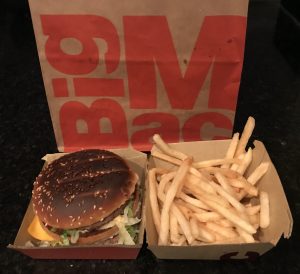 Chicago-based, fast-food powerhouse McDonald’s has locations in over 100 countries. Accordingly, it is difficult nowadays to find people in the world that are not familiar with the Big Mac, a McDonald’s staple since 1967. Regardless of which language a McDonald’s menu is displayed, consumers relate the word “Big Mac” to the burger’s signature structure: two all-beef patties, “special sauce,” American cheese, lettuce, pickles, and onion, all served in a three-part sesame seed bun.
Chicago-based, fast-food powerhouse McDonald’s has locations in over 100 countries. Accordingly, it is difficult nowadays to find people in the world that are not familiar with the Big Mac, a McDonald’s staple since 1967. Regardless of which language a McDonald’s menu is displayed, consumers relate the word “Big Mac” to the burger’s signature structure: two all-beef patties, “special sauce,” American cheese, lettuce, pickles, and onion, all served in a three-part sesame seed bun.
McDonald’s Trademarks on a Global Scale
McDonald’s trademarks are one of its most valuable assets. In 2002, the net present value of the McDonald’s trademarks in the global market was estimated to be over $14 trillion. Undoubtedly, the “Big Mac” trademark significantly contributes to that valuation as about 28 Big Macs are sold globally every second. Yes, you read that correctly: 28 Big Macs a second!
For McDonald’s, protecting its trademarks is an international issue. To proactively enforce and protect its trademarks, McDonald’s has successfully gone after restaurants in many different countries, including the Philippines, Cayman Islands, and South Africa—regardless of their size—that have used similar marks arguably confusing to consumers. That is, until McDonald’s challenged Supermac’s, a relatively small Ireland-based fast-food chain operating since 1978, in the European Union Intellectual Property Office (EUIPO), the regional agency that governs trademarks in the European Union (EU).
McDonald’s v. Supermac’s
The battle began when McDonald’s challenged Supermac’s application with the EUIPO to expand its trademark use outside of Ireland. McDonald’s claimed that the use of the “Supermac’s” mark would cause consumer confusion with its “Big Mac” trademark in other EU countries. Supermac’s responded to the global giant by seeking to have the valuable “Big Mac” trademark revoked in the EU. In other words, Supermac was trying to take away McDonald’s trademark in all EU member countries. In a tasty David v. Goliath matchup, the EUIPO sided with Supermac’s and the legal stones it fatally hurled at McDonald’s. David, which, in this scenario, is Supermac’s owner Pat McDonagh, said shortly after the landmark decision, “…just because McDonald’s has deep pockets and we are relatively small in context doesn’t mean we weren’t going to fight our corner.”
How was an underdog like Supermac’s successful? The answer lies in trademark law. The Agreement on Trade-Related Aspects of Intellectual Property Rights (TRIPS)—an international agreement between the 164 member nations of the World Trade Organization—states that “[a]ny sign, or any combination of signs, capable of distinguishing the goods or services of one undertaking from those of other undertakings, shall be capable of constituting a trademark.” A company operating or selling products in multiple countries must have a trademark in each country that it seeks protection in—and satisfy the specific requirements of each of those countries. Therefore, a United States trademark does not necessarily qualify for trademark protection in China. Furthering the complexities of trademark protection internationally, each country has its own unique laws concerning trademarks that apply even after a trademark is initially obtained, i.e. registered; in particular, there are different rules about enforcement, as well as how a company may potentially lose an initial trademark.
McDonald’s Greasy Slip-up in the EUIPO
Under the trademark laws of the EU—of which Ireland is a member (at least for now)—a registered trademark can be revoked if the owner cannot prove “genuine use” of the contested trademark as a service or product identifier continuously over a 5 year period, regardless of actual use. McDonald’s argued that its extensive use of the “Big Mac” trademark in Germany, France, and the United Kingdom was sufficient proof to establish “genuine use” throughout the EU. The EUIPO disagreed.
This decision of the EUIPO may seem counterintuitive to anyone who has been in the EU and seen Big Macs sold there. However, this is actually a good example of how key nuances in law, and especially trademark law, have important impacts. In this case, McDonald’s failed to satisfy the evidentiary standard of genuine use on goods and service. Why? McDonald’s provided some advertising brochures, a Wikipedia print out, and affidavits from some of its employees. But, the McDonald’s affidavits were of its own employees, and thus given less evidentiary weight—at least under EU law. Moreover, advertisements and even the Wikipedia entry don’t technically show that the trademark was used on goods that were sold. McDonald’s should have included concrete examples such as invoices to show actual purchases.
The Future of Big Macs in Europe
The euro Big Mac is not burnt to a crisp just yet. McDonald’s is likely to appeal the EUIPO decision revoking its EU trademark all the way up to the EU’s highest court in Luxembourg. In the meantime, McDonald’s competitors operating within the EU are free to use the “Big Mac” trademark without fear of legal repercussions. For example, shortly after the EUIPO decision, Burger King’s in Sweden renamed their Whopper sandwiches “Like A Big Mac, But Actually Big” and “Kind Of Like A Big Mac But Juicier And Tastier.” We will have to wait and see if the Big Mac has a future in the EU or if it will go up in smoke.
Image by Michael Sanko. No Rights Reserved.
Michael Sanko
Associate Blogger
Loyola University Chicago School of Law, Juris Doctor Candidate 2020